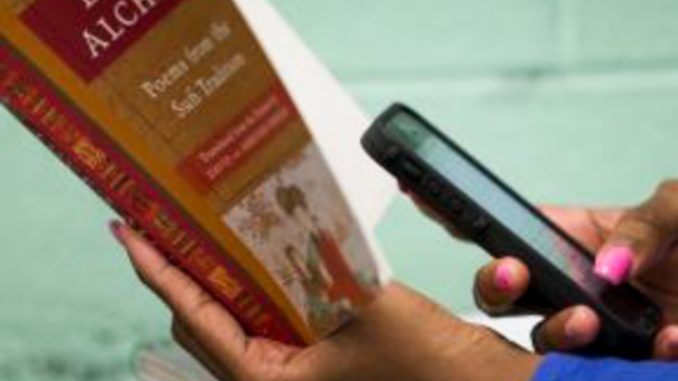
It looks like a professor’s nightmare.
In Jordan Shapiro’s Intellectual Heritage class, students’ eyes are fixed downward at their phones while their thumbs dart; almost all of them are using Twitter. Shapiro lectures on. He doesn’t mind – in fact, tweeting in class was his idea.
The educational technology expert instructs his Mosaic students to tweet about class material using the hashtags “#Mosaic1” or “#Mosaic2.” Shapiro tweets back to his students under the Twitter handle @jordosh. All of the tweets are projected in front of the classroom on a massive screen, which Shapiro said allows for “another track of conversation.”
Tweeting in Shapiro’s class isn’t mandatory, but it can help raise a student’s participation grade. Shapiro said students usually tweet about the books they read, like Freud’s “Introductory Lectures on Psychoanalysis” or the “Epic of Gilgamesh.”
“[Students] are able to have a different kind of conversation,” Shapiro said. “If you want to interject a joke or non-connected comment, you can [tweet] without deflecting the conversation to other places.”
Shapiro, who teaches only Mosaics courses, said the idea came to him when he started teaching as an adjunct professor at Temple a few years ago.
“I noticed there were these long sections in every syllabus that said, ‘No smartphones in the class, no Twitter,’” he said. “I read it, and it made me so anxious. So I immediately decided I’m going to f— with the system. I said, ‘Here’s the deal: I want you to take your smartphone out. I know other teachers tell you to put it away, but I want it out. I want you to be so engaged with what we’re doing in class that you can’t help but share it on social media.’”
Of course, this doesn’t mean that phones won’t distract students, but Shapiro said he believes the benefits of using Twitter outweigh the downsides. He said it’s ultimately up to the students to know how to multitask.
“You can daydream in a class too, right? It’s your job to focus,” he said. “It’s not my job to eliminate all distractions.”
Shapiro said Twitter should be used as a form of communication in addition to class discussion, rather than in place of it. He said he believes students and professors should be communicating on a regular basis outside of the classroom.
“We need to get rid of this notion of ‘class time,’” Shapiro said. “I firmly believe in not just meeting with instructors once a week. All week, I’m sharing things on your [Twitter newsfeed] and I’m trying to get people to see in a way where those things aren’t separate.”
Aaron Stevens, a 2013 graduate, said he took Mosaic: Humanities Seminar II with Shapiro last year. The journalism alumnus said students like himself frequently used Twitter outside of class to discuss class material. Stevens said Twitter was helpful in class, but he thinks it should only be used in certain discussion-based courses.
Shapiro said this is why Twitter is a popular tool in the Intellectual Heritage program.
“What we want to do is make sure that students learn to have articulate, thoughtful conversations in multiple ways,” Shapiro said. “On email, face to face, blogging and social media – these are all normal ways of talking today.”
Elizabeth Hayes Alvarez, who also teaches in the Intellectual Heritage program, said she doesn’t grade students’ tweets, but often discusses them in class. She said she encourages her students to follow her, but lets them know she won’t follow them back, as to not violate their privacy.
Freshman Joanna Marzano said her Mosaic: Humanities Seminar I professor, Linda Lee, uses Twitter for assignments outside of class. Marzano said it is mandatory for students to tweet about class material at least 10 times per week.
The psychology major said that although the social network helps her organize her thoughts while she works, it’s a surprisingly time-consuming task.
“It’s kind of a hassle,” Marzano said. “We have to take five of our own tweets and 10 of our classmates’ tweets and write papers and draw conclusions from them, so it’s a lot of extra work.”
Unlike Lee, Shapiro instructs his students to use Twitter during class, but he said he plans on eventually using other forms of social media, like Tumblr, for assignments outside of class.
“Right now there is this separation where we use a different kind of thinking and approaching the world when we’re in school than when we’re not, which to me is crazy,” Shapiro said. “We have this entire fantastic university full of brilliant scholars who can offer a ton of education and advice on living your life. I want you to see your education whether you’re on Twitter, on Facebook or writing an email.”
Claire Sasko can be reached at claire.sasko@temple.edu.



Be the first to comment